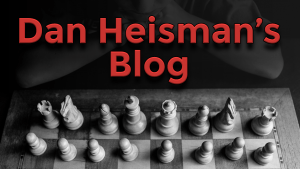
Get Better At Chess For Everyone: Comparison
When you see a good move, don't play it. Look for a better one.
This is the number-one principle in chess. Over the years, I have also told my students:
You are trying to find the best move you can in a reasonable amount of time.
I once read that psychologists studying chess players found an interesting difference between strong players and much weaker ones. Strong players compare candidate moves. Weaker players, for the most part, do not.
From my experience in listening to students "think out loud," I've found this to be true. Weaker players jump around, looking at fewer candidate moves, and rarely comparing them. They hone in on a candidate they like, and if they are trying to play slowly, attempt to convince themselves that the move they are about to play does what they want. Strong players don't play that way.

Time to slow down and have a think.
Suppose a strong player wants to compare the candidate moves A and X. There may be other candidate moves, but for now, let's just assume there are two. The player wants to know which one is better.
What does he need to do?
Except in extreme cases, such as a forced checkmate, the player needs to know what will happen after A and X so as to compare outcomes. Therefore, the strong player will attempt to identify move sequences that might occur. For example, move A is followed by the opponent's reply B, and then we respond with C. The player should compare this to a similar sequence XYZ. The key is to visualize and compare the positions after C and Z. We can call these C* and Z*.
This requires several skills:
- Deductive Logic -- The player must know that B is a logical reply to A (and Y to X). It either meets some demand of the position after A (such as addressing a threat) or B is a dangerous move that must be met on the player's next move, C.
- Visualization -- You can't play what you don't see. If you can't clearly visualize the positions C* and Z* after the moves ABC and XYZ, you can't compare them.
- Patience -- In slow chess, you have to take your time. You can't compare (or even find) ABC and XYZ if you are taking only 17 seconds on each move.
- Ability to assess quiescence -- Unless a move is a speculative sacrifice, you need to reach quiescence before you can evaluate. Quiescence means a point in the sequence (say after moves C or Z) where there are no further forcing moves (checks, captures, or threats) for either side.
- Evaluation -- After the moves C and Z lead to positions C* and Z*, you need to evaluate C* and Z*. I suggest that the four major evaluation criteria are material, king safety, activity of the relative forces/armies, and pawn structure. If indeed the sequences ABC and XYZ are "best" (and that's no given), then if C* is a better position for you than Z*, that means move A is a better move than X.
Does this take time? Absolutely. That's why strong players, who can calculate quickly and accurately, take almost all their time every game. It's not a coincidence that at tournaments the first players finished are the weaker players, and the last ones finished are the stronger players. In order to play chess well, you have to do the right things every move.
It only takes one bad move to lose a game.

Ugh, did I really just hang that knight?!
Many of my students are held back by their inability to perform the skills listed above. For example, they might be too impatient, or they might not understand the need to consistently take time. Alternatively, they might wish to take their time but be frustrated by their inability to visualize well enough to perform the above tasks.
In my "Pilot" article, I mentioned that many players who believe that 15-minute games are "slow chess" have trouble developing their visualization skills. This makes sense. A typical 40-move game would have 15x60 = 900/40 = 22.5 seconds per move.
That's hardly time to see if move A is safe, much less find ABC, much less evaluate C*, much less do the same for XYZ too. Finally, there's certainly no time to finally compare the positions C* and Z*.
While practice might not make perfect, practice does make better. That means players who like to only play intermediate time controls have a very difficult time improving their visualization.
Many of these same players often approach me for lessons and yearn to be titled players like experts and masters. In the United States, the U.S. Chess Federation does not award these titles except for achievements in long time-control play. They define long time controls as at least 30 minutes per side per game.
Even that time control is considered fast for serious play. The traditional time control for important events like the World Open is something like 40 moves in 110 minutes with a 10-second delay. That's roughly 11-12 times slower than a 15 minute game.
It's no wonder that many online players have trouble achieving their goals.
Let's take a position from one of my (G/30) games:
In a sense, this example is rather straightforward. Black's knight on b5 is attacked and must move. There are three candidate moves:
-
15. Nc3
-
15. Na7 threatening the fork on c6, and
-
15. Nxc7
None of these requires very deep analysis. Still, we need to take at least some time and analyze and evaluate each.
After 15.Nc3, things are relatively quiescent so we can evaluate with much further analysis. White has the better pawn structure and good squares for all his pieces. Black has the bishop pair as he will in all these lines. White has a pleasant game, but is it better than the other moves? Only analysis can tell.
After 15.Na7, things are not quiescent. Black has to guard against the threat of 16.Nxc6. This he can do in several ways. For example, 15...Bb7, 15...Bd7 or maybe 15...Qd5 are possible. Then White is threatening Bxa5, but that move leads to two tactical concerns. First, the knight may get trapped on a7, and second, if the bishop captures on a5, there could be a skewer on the a-file.
White would at least have to get a feel for how easy it will be to extricate the knight. Not easy, it appears, but the situation will remain tactical for the near future. This might require further investigation if we were to lean toward this move. For now, it's speculative at best.

Careful friends, no need to speculate!
15.Nxc7 is straightforward. White exchanges his knight and then begins to attack the vulnerable pawns on the queenside. Unlike the 15.Nc3 line, there is no piece blocking the rooks and queen from attacking the c-pawns along the c-file. Black, in turn, lacks targets so might have to sacrifice a pawn to open lines for the bishop pair. A sample line might be 15.Nxc7 Qxc7 16.Qc2 Bf5. The c5 pawn can be attacked more times than it can be guarded. White will win it, and Black likely does not have enough compensation.
Which is best? Well, Stockfish 7 (a resource I use after the game to evaluate my analysis and evaluations) says it is not even close. The simple 15.Nxc7 is best by a large margin. Not perceiving this large margin during the game, I gave in to my love for complications and plunged ahead with 15.Na7? Matt, as usual, played accurately, and I got a bad position, but later I lucked out in the complications and won with a nice attack:






